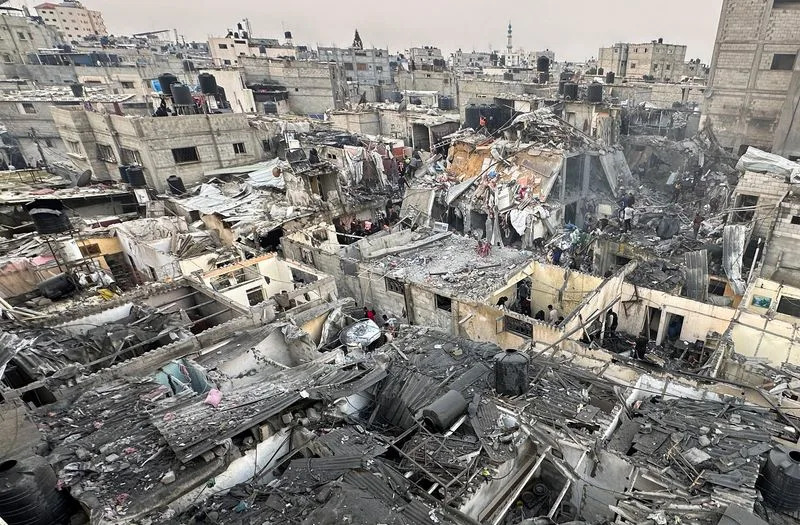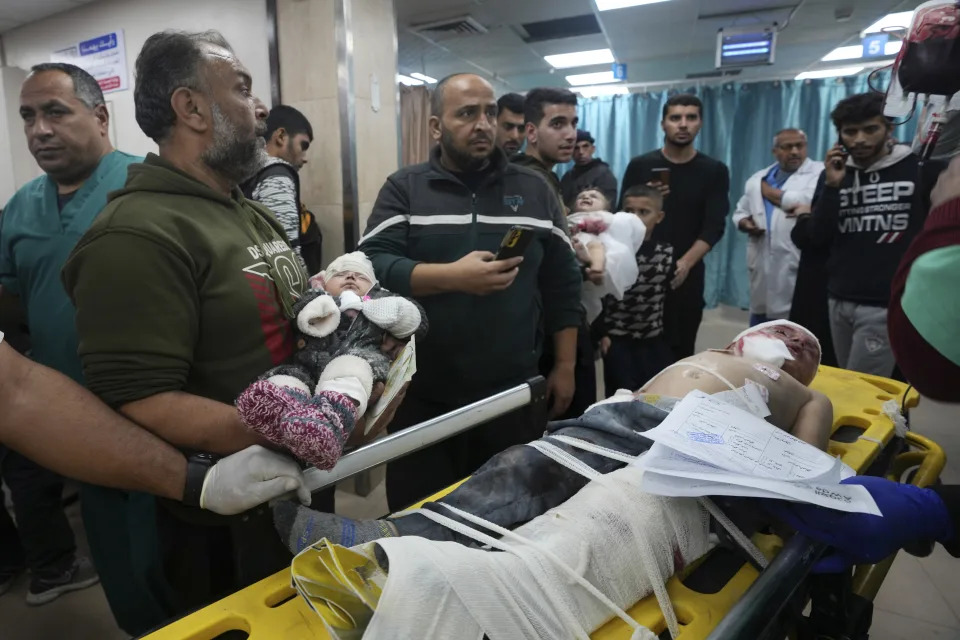Nearly a fifth of Gaza's buildings destroyed or damaged: UN estimate

Nearly 40,000 buildings or about 18% of all pre-conflict structures have been damaged or destroyed in the Gaza Strip since the conflict began on Oct. 7, a U.N. assessment showed on Tuesday.
Israeli air strike on Palestinian houses, amid the ongoing conflict between Israel and the Palestinian Islamist group Hamas, in Rafah.
Israeli forces unleashed an aerial and ground blitz against Hamas in Gaza after deadly cross-border attacks by the enclave's ruling Islamist group on Oct. 7. Around 1.9 million people, or about 85% of the population, have fled their homes as a result.
The latest estimate, based on a Nov. 26 image, was produced by the United Nations Satellite Centre, where analysts examine very high resolution satellite images to find damaged buildings and publish maps that can guide relief work and rebuilding plans during natural disasters and conflicts.
Estimates such as this based on high-resolution satellite images might still under-estimate the scale of destruction since they do not show all building damage - for example, a collapsed building with an intact roof can look undamaged.
"There has been a 49% increase in the total number of damaged structures, highlighting the escalating impact of the conflict on civilian infrastructures," UNOSAT said in a statement.
The assessment showed the worst affected areas were the two northern governorates of Gaza and North Gaza, which collectively accounted for 29,732 buildings of the 37,379 damaged or destroyed, or about 80% of the total.
An earlier U.N. assessment released on Nov. 7 said that 25,050 buildings had been damaged or destroyed or about 10% of the total structures in Gaza.
UNOSAT did not estimate damage by type of building. Some figures from Gazan authorities earlier in the conflict indicated widespread damage to housing. One estimate quoted in a U.N. report on Oct. 21 estimated that at least 42% of all housing units had been destroyed or damaged.
Packed hospitals, treacherous roads, harried parents: Newborns in Gaza face steeper odds of survival.
The birth of their daughter should have marked the beginning of a joyful chapter for the young Palestinian couple.
Instead, the devastating war in Gaza, now in its third month, has turned childbirth and parenthood into a time of worry and fear for Salim and Israa al-Jamala.
First, they endured a perilous journey, dodging missile fire, to reach a maternity ward. And now, the couple is sheltering with their newborn in the partially tented courtyard of another hospital where they can't care properly for their now 3-week-old daughter, her mother's namesake.
His wife's breast milk is not sufficient because she cannot eat enough as a result of widespread food shortages, said the 29-year-old Salim, rocking baby Israa, swaddled in blankets in a crib cobbled together from wood scraps. Baby formula and medicine for the infant's persistent cough are not available and in any case not affordable.
The war, triggered by a deadly Oct. 7 Hamas assault on southern Israel, has unleashed unimaginable destruction, with more than 18,000 Palestinians killed and close to 50,000 wounded in Israel's offensive, according to health officials in Hamas-run Gaza. The initial Hamas attack killed about 1,200 people in Israel, most of them civilians.
Amid the devastation, about 5,500 births are expected over the next month, out of an estimated 50,000 women in Gaza who are currently pregnant, according to the World Health Organization.
Yet the health sector is close to collapse, with two-thirds of Gaza's 36 hospitals now out of service. The 12 remaining health facilities are only partially operational. Even in the functioning hospitals, doctors report a lack of basic medicines and the kind of equipment needed to treat newborns, including ventilators, formula milk and disinfectant.
The severe shortage of fuel is another major concern for hospitals that have run solely on generators since the early days of the war when Israel cut Gaza's electricity supply.
“Electricity sometimes comes on for a few minutes" before dropping off, said Wisam Shaltout, head of the neonatal intensive care unit at the Al-Aqsa Hospital in Deir al-Balah in central Gaza.
Salim and Israa's odyssey began in mid-October. During that period, the Israeli military had been issuing daily warnings to residents of northern Gaza, including Gaza City, to head to the southern half of the territory ahead of a looming Israel ground offensive in the north.
Heeding the warnings, Salim, a heavily pregnant Israa and their 5-year-old son fled their home in the Sheikh Radwan neighborhood of Gaza City and headed south on foot. The family of three shortly arrived at Shifa hospital in Gaza City before managing to secure a taxi later that day to take them to Al-Aqsa Hospital where they found shelter.
When 26-year old Israa went into labor on Nov. 23, the pair were told to head to Al-Awda Hospital, near the Nuseirat refugee camp, as it still had a maternity ward.
The couple managed to find a Red Crescent ambulance to take them to Al-Awda, just 6 kilometers (3.7 miles) away. But it was a frightful stop-start journey that took more than an hour because three airstrikes hit near the road.
Most arriving at Al-Awda's maternity ward have no vehicle to help. Some pregnant women are too scared to go at all, fearing airstrikes that in some cases have also struck ambulances, said Dr. Yasmin Kafarneh, who runs the obstetrics department at Al-Awda.
She said she believes her department is the only functioning maternity ward in southern Gaza. Before the war, the department used to handle around six births a day. Now, pregnant women arrive from all over and more than 70 babies are delivered each day.
Under the current conditions, first-time mothers are permitted to stay and receive treatment in the hospital for around four hours after giving birth, while those who have previously given birth can stay for only half that time.
Israa gave birth at 2 a.m. on Nov. 24, but the joy was short-lived. Just after daybreak, the family was told by medical staff they had to leave to make room for others.
They secured a donkey cart to carry them back to their shelter at the Al-Aqsa Hospital. They have little to eat, some days just onions.
Their neighbors make fires to stay warm, sometimes burning plastic that releases toxic fumes. “The atmosphere here is all smoke, all dust," Salim said. “It is not an appropriate environment for a newborn girl!”
The baby's health has deteriorated, said Salim, troubled by her persistent cough.
Israa was born just hours before a cease-fire took effect that lasted a week. After fighting resumed and ground forces advanced in central and southern Gaza, their shelter became even more crowded.
Given the circumstances, Salim said he has done the best he can. But he's scared for his daughter. “I do not know whether she will be alive tomorrow," he said.
- Questions and Answers
- Opinion
- Story/Motivational/Inspiring
- Technology
- Art
- Causes
- Crafts
- Dance
- Drinks
- Film/Movie
- Fitness
- Food
- Games
- Gardening
- Health
- Home
- Literature
- Music
- Networking
- Other
- Party
- Religion
- Shopping
- Sports
- Theater
- Wellness
- News
- Culture
- War machines and policy



